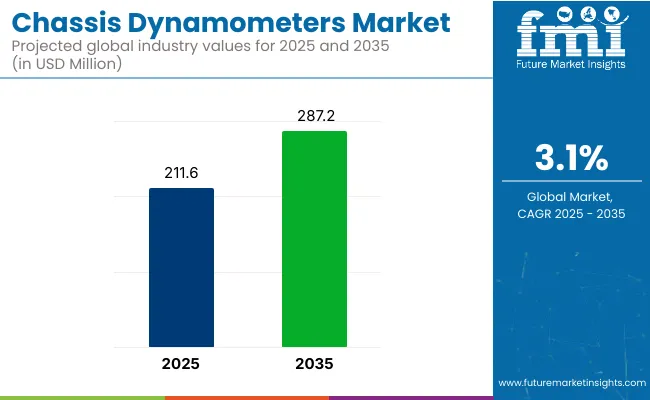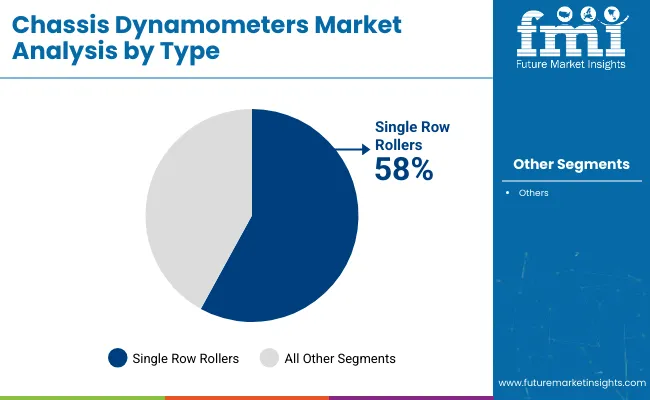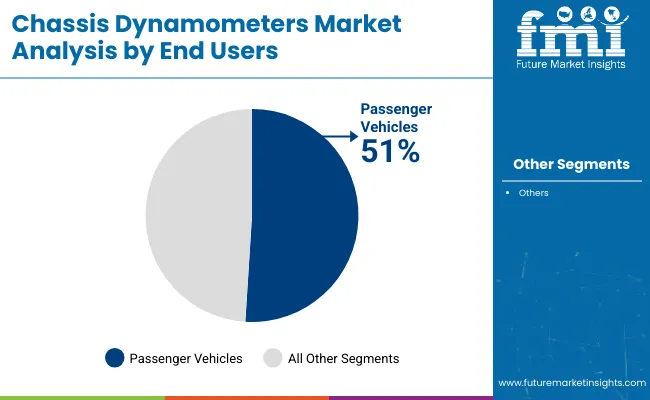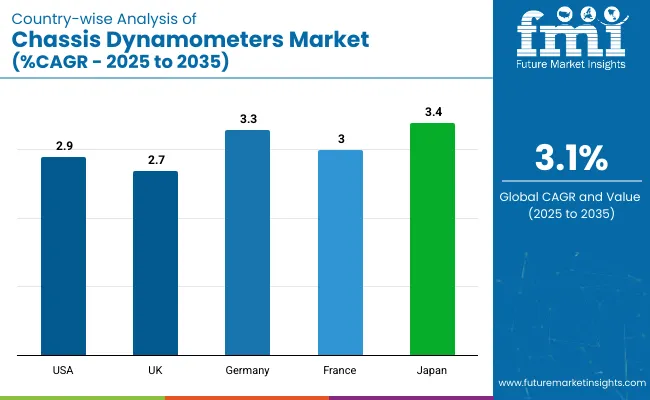The global chassis dynamometers market is valued at USD 211.6 million in 2025 and is set to reach USD 287.2 million by 2035, which shows a CAGR of 3.1%. Growth is being influenced by stringent emissions regulations, rising production of electric and hybrid vehicles, and the increasing demand for accurate, real-world vehicle performance testing. The shift toward more environmentally compliant and technologically advanced automotive systems is accelerating the market’s expansion.

| Metric | Value |
|---|---|
| Estimated Size (2025) | USD 211.6 million |
| Projected Value (2035) | USD 287.2 million |
| CAGR (2025 to 2035) | 3.1% |
The USA is likely to continue holding the largest market share, supported by EPA regulations and a robust automotive R&D infrastructure. Japan is projected to grow the fastest, with a 3.4% CAGR, as hydrogen and hybrid vehicle testing intensifies. In the product segment, single row rollers dominate, accounting for 58% of the market, primarily due to their affordability and suitability for light and heavy-duty vehicle testing, while by end users, passenger vehicles hold a prominent share of 51% as well in 2025.
Meidensha Corporation is expected to record strong gains due to growing demand for heavy-duty dynamometers across Asian markets. However, profitability pressure may be faced by firms such as Mustang Dynamometer due to rising infrastructure costs and competition in emerging economies. Europe may also face hurdles due to high installation and upgrade costs associated with smart testing infrastructure. Efforts are being intensified by regional players to localize production and minimize lead times in cost-sensitive areas.
Over the forecast period, artificial intelligence and simulation-based testing are expected to reshape market dynamics. Increased EV production and autonomous vehicle testing will necessitate advanced systems, particularly in Asia-Pacific. Dynamometer systems integrated with cloud analytics and automation tools are projected to gain prominence, especially among OEMs transitioning to AI-driven testing protocols. Additionally, greater reliance is expected to be placed on predictive diagnostics to reduce downtime and enhance operational efficiency.
The global chassis dynamometers market is segmented by type into single row rollers, double row rollers, by end users-light commercial vehicles, heavy commercial vehicles, passenger vehicles, racing vehicles, and by region it covers North America, Latin America, Western Europe, Eastern Europe, East Asia, South Asia Pacific, and Middle East and Africa.

Single row rollers are projected to dominate the chassis dynamometers market with a 58% share, owing to their affordability, minimal maintenance requirements, and ease of integration into standard testing setups. These systems effectively replicate real-world driving conditions, making them ideal for emission regulation compliance. Their versatility across both light-duty and heavy-duty vehicle testing environments further enhances their appeal among OEMs and regulatory testing facilities worldwide.

Passenger vehicles are expected to account for approximately 51% of the end-user segment, as automakers intensify efforts to comply with emissions mandates and improve EV performance. Chassis dynamometers are increasingly used to test battery efficiency, regenerative braking, and drivetrain calibration. With the global surge in electric and hybrid passenger car production, demand remains high for precision testing systems, especially in Europe, North America, and fast-growing Asian automotive hubs.
Recent Trends in the Chassis Dynamometers Market
Key Challenges Facing the Market

The chassis dynamometers market in the USA is expected to expand at a CAGR of 2.9% from 2025 to 2035. Growth is supported by stringent EPA fuel economy regulations, advanced R&D labs, and a strong EV manufacturing base. Continued investments in autonomous vehicle testing infrastructure and the push for AI-integrated testing technologies further strengthen the USA market outlook. Additionally, the presence of leading automotive innovation hubs across multiple states reinforces continuous system upgrades.
The chassis dynamometers market in the UK is projected to grow at a 2.7% CAGR during 2025 to 2035. The country’s push toward net-zero carbon emissions by 2050 and Brexit-aligned emission standards has prompted vehicle makers to upgrade testing infrastructure. The presence of cutting-edge testing centers continues to support long-term market resilience. Automotive policy reforms are accelerating partnerships between public testing labs and EV manufacturers.
The chassis dynamometers industry in Germany is forecasted to register a CAGR of 3.3% from 2025 to 2035, driven by its position as Europe’s automotive powerhouse. The implementation of EURO 7 norms and the shift to electrified fleets are encouraging manufacturers to adopt more precise and AI-powered dynamometers. Government-backed green mobility programs are also pivotal in driving investment. The rise of testing-as-a-service platforms is also gaining traction among Tier-1 suppliers.
The chassis dynamometers market in France is estimated to grow at a 3.0% CAGR between 2025 and 2035, owing to rapid electrification and strong policy backing for environmental sustainability. Local automakers are increasing reliance on AI-driven simulation tools and modular testing systems to meet future compliance and export standards. Incentives for sustainable mobility startups are also boosting adoption of compact testing units.
The chassis dynamometers market Japan is anticipated to grow at a 3.4% CAGR from 2025 to 2035, the highest among top countries. This growth is underpinned by strong innovation in hydrogen and hybrid vehicles, along with heavy R&D spending by automotive giants. AI-integrated dynamometers and blockchain-supported validation processes are gaining rapid traction. The country’s emphasis on robotics and precision manufacturing is also driving demand for high-tech testing equipment.
The chassis dynamometers market is moderately fragmented, with a mix of global manufacturers and regional specialists competing across niche application areas and vehicle types. Key players such as Rototest, SuperFlow Technologies, MAHA MaschinenbauHaldenwang GmbH, and SchenckRoTec GmbH are focusing on precision testing systems, integration of AI-driven analytics, and EV powertrain simulation capabilities. Competition is increasingly driven by innovation in high-speed testing platforms, affordability, and automation-ready systems tailored to meet evolving global emission regulations.
Company strategies are centered on product modularity, expansion into high-growth EV testing markets, and enhancing user experience through cloud connectivity and simulation software integration.
For example, companies like Dynapack and SuperFlow are targeting performance vehicle and motorsports applications, while SchenckRoTecand other companies continue to strengthen their presence in regulatory and OEM-grade testing solutions. Partnerships with R&D institutions and investments in local production to reduce lead time are also being prioritized.
Recent Chassis Dynamometers Industry News
In July 2024, SchenckRoTec inaugurated its Green Technology Center in Darmstadt, Germany to focus on innovative rotor testing solutions.
| Report Attributes | Details |
|---|---|
| Current Total Market Size (2025) | USD 211.6 million |
| Projected Market Size (2035) | USD 287.2 million |
| CAGR (2025 to 2035) | 3.1% |
| Base Year for Estimation | 2024 |
| Historical Period | 2020 to 2024 |
| Projections Period | 2025 to 2035 |
| Market Analysis Parameters | Revenue in USD millions/Volume in units |
| By Type | Single Row Rollers, Double Row Rollers |
| By End User | Light Commercial Vehicles, Heavy Commercial Vehicles, Passenger Vehicles, Racing Vehicles |
| Regions Covered | North America, Latin America, Western Europe, Eastern Europe, East Asia, South Asia Pacific, Middle East and Africa |
| Countries Covered | United States, Canada, United Kingdom, Germany, France, China, Japan, South Korea, Brazil, Australia |
| Key Players | Rototest , SuperFlow Technologies, Dynapack Dynamometers, MAHA Maschinenbau Haldenwang GmbH, SAJ Test Plant Pvt. Ltd., Schenck RoTec GmbH, Taylordyno , Vtech Dynamometers, Dynocom Industries Inc., Froude, Inc., Others |
| Additional Attributes | Dollar sales by value, market share analysis by region, country-wise analysis |
In terms of Type, the industry is divided into Single Row Rollers Chassis Dynamometers, Double Row Rollers Chassis Dynamometers
In terms of End Use, the industry is divided into Light Commercial Vehicles, Heavy Commercial Vehicles, Passenger Vehicles, Racing Vehicles
The report covers key regions, including North America, Latin America, Western Europe, Eastern Europe, East Asia, South Asia, and the Middle East and Africa (MEA).
The global chassis dynamometers market is valued at USD 211.6 million in 2025.
The market is projected to grow at a CAGR of 3.1% from 2025 to 2035.
Single row rollers lead the market with a 58% share due to their cost-effectiveness and ease of use.
Japan is expected to grow at the fastest pace with a 3.4% CAGR over the forecast period.
Major players include Horiba Ltd., AVL List GmbH, Meidensha Corporation, and Dynojet Research Inc.






Full Research Suite comprises of:
Market outlook & trends analysis
Interviews & case studies
Strategic recommendations
Vendor profiles & capabilities analysis
5-year forecasts
8 regions and 60+ country-level data splits
Market segment data splits
12 months of continuous data updates
DELIVERED AS:
PDF EXCEL ONLINE
Chassis Leveling Valves Market Growth - Trends & Forecast 2025 to 2035
In-Chassis Cooling Market - Growth & Demand 2025 to 2035
Bus Chassis Market
Excavator Chassis Market Forecast and Outlook 2025 to 2035
Automotive Chassis Electronics Market

Thank you!
You will receive an email from our Business Development Manager. Please be sure to check your SPAM/JUNK folder too.
Chat With
MaRIA